
|
||
|
Portland art blog + news + exhibition reviews + galleries + contemporary northwest art
|
||
Julia Oldham at Portland Pataphysical Society 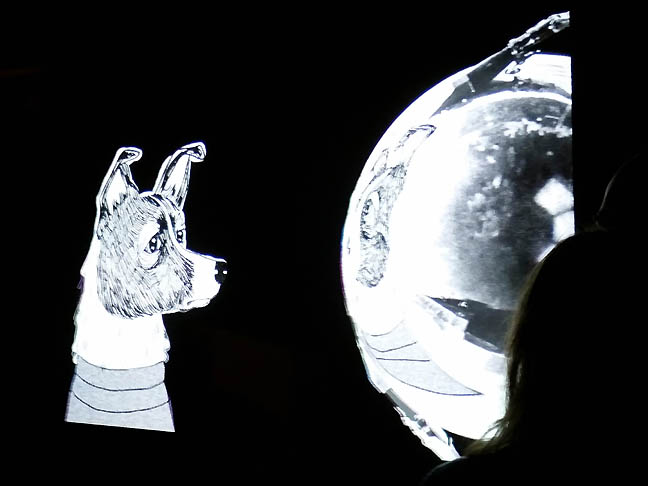 Installation view of Farewell Brave Voyager Julia Oldham's Farewell Brave Voyager at the Portland Pataphysical Society may be the most emotionally demanding exhibition one will see in Portland all year. It is easily the strongest solo show on view at the moment, presenting a tale of science, sacrifice and a compelling combination of whimsy laced with a lethal dose of tragedy. Those are all hings that have always accompanied scifi thrillers like Gravity, Alien and 2001: A Space Odyssey. Where this video art exhibition differs is it plays more upon rawer empathy than a filmmakers emotional buy-in and adrenaline management. Because it deals in a more unconditional empathy most sensitive Portlanders will have some trouble with this exhibition, which follows the fates of two dogs and a robot in space. Still, it is really worth a visit if you love explorers and or animals as it fleshes out the most existential of moments, that impending final one. Be prepared, on opening night there were several visitors weeping openly. 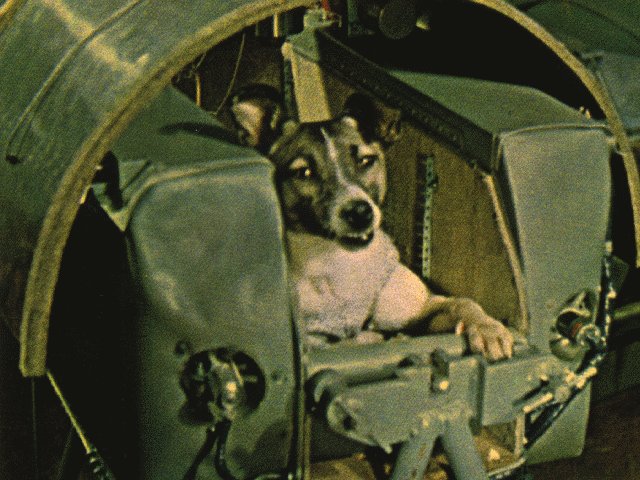 Laika 1957, courtesy of NASA One of the dogs depicted, Laika, is historical... being first sentient Earthling to explore space aboard the Sputnik 2 spacecraft in 1957. According to conflicted accounts she died 4 hours into the flight after completing as many orbits, while the stress and high temperatures sealed her fate. These are dry facts but Oldham handles the historical account with respectful graphic design and production quality worthy of such sacrifice. 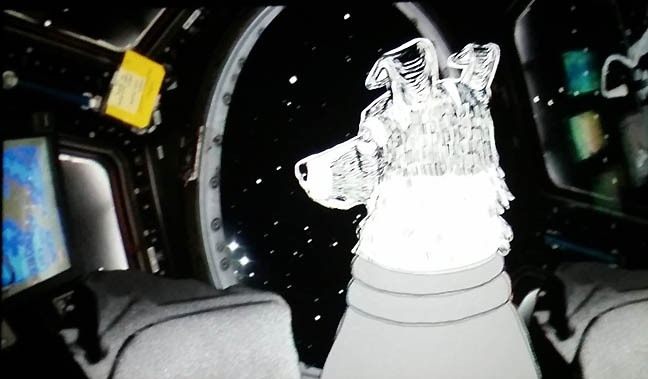 Still from Laika's Lullaby The largest video Laika's Lullaby, depicts her compelling situation as Sputnik 2 leaves the planet with its payload. The hopeful opening sequences do not foreshadow the death sentence committed in the name of human curiosity. Instead, the cartoon imagery evokes the kind of intrepid curiosity that Star Trek and other dramas have made into the hallmark of space exploration. The eager hopefulness that most dogs posses is perfectly conveyed here and by all accounts Laika was chosen for the mission because of her calm demeanor. As time passes though the Kubrickian vastness of space is reflected in Laika's eyes and she is clearly hyperventilating from the stress. She is in a harness, and in fact she was highly trained for the mission. Oldham depict Laika as stoic as John Glenn or any human with "the right stuff." 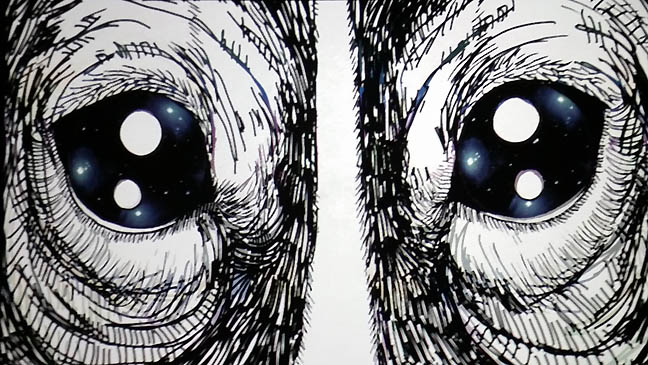 Still from Laika's Lullaby As time goes by though the focus of the imagery turns more to Laika's intensifying breathing, and the way her tongue licks the window, mimicking the solar flares of the sun. Historically, there was no window but as a symbol of animal curiosity the storytelling device is powerful. Eventually, we see her ghostly image looking at her own craft as if she is major Tom in David Bowie's song, she is already dead? But it is the full and solemn eyes of Laika that look up at us that are most gut wrenching. Anyone who has seen a mammal of any kind die will know this look. It is full of Kubrickian wonder-doom with hints of William Kentridge style quiet existentialism. She is alone, giving the phrase, "die like a dog" new nobility. The closeups of her deep eyes and rasping tongue are truly hard to take. Then the video cuts to another dog, seemingly capable of leaving the capsule with nothing but a fishbowl on its head looking back at the capsule. Laika's body orbited Earth for 163 days before burning up on reentry a fact that isnt obscured by the Kubrickian way Oldham made Laika's hallucinatory final moments. The dreamy weightless soundtrack by musician Lindsay Keast works perfectly and isn't overbearing. The experience was profound. This was by all accounts a highly trained and good natured dog that never actually signed up or knew the finality of the mission she was on. There was no moral opportunity for consent. Laika was simply a stray dog that wound up being the first astronaut, a great explorer. 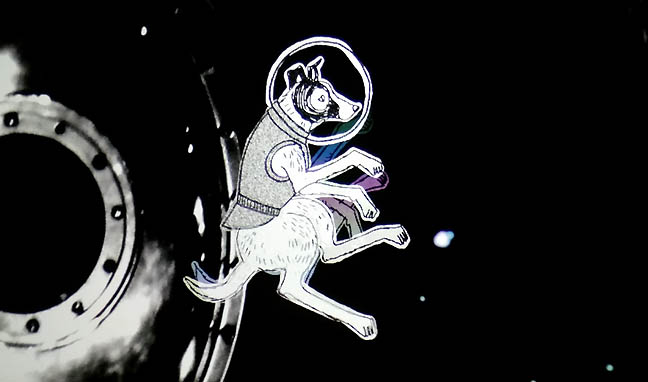 Laika's Lullaby (still) It is odd how mankind's need to rush into space without any hope of survival that put her there. It was a perfect reminder of the cold war nuclear arms race that the space race was a part of and the human need to do things just because we can, which is very linear thinking. It makes sense that it happened. It also makes sense that there is another less serious cartoon dog, just like hundreds of other cartoon dogs that can somehow survive in space without proper equipment. I like how Oldham includes a parallel character. It also reminds me how far we have come, as ethical discussions now would be so different. Not ideal of course, but certainly the need for at least a chance of survival would be insisted upon now. The piece is also yet another example of how we humans can connect to cartoon dogs easier than video of real human beings on the news. I am a little surprised that no local curator has done a proper exhibition of existential animals in contemporary art lately? Somehow though, the crushing isolation of dying alone in space as a martyr for science in cartoon form works. It reminds of why art is powerful... it isnt really accurate to the facts (no window etc.) but a fictionalized cartoon version of Liaka and some fanciful space dog gives us an empathetic valence. Depending on how we evolve (and art has a role in this) we can explore our humanity long after we have explored space. The second video is in the same vein but I feel like having a weepy human reading an ode to the sacrifice to science that will be remembered is unnecessary. It isnt pure melodrama but it lacks the grace of Laika's Lullaby. In general a snuff flick doesnt need a sequel and as Werner Herzog's Grizzly Man demonstrated perfectly, some things simply dont need to be depicted. See Farewell Brave Voyager and experience the vectors between humanity's fatal need for exploration, the ambition of nations, and the sticky web of morality that being humane weaves. As an exercise in history and unconditional empathy it suggests that the final frontier for humanity might be more existential than extraterrestrial. At The Portland Pataphysical Society in the Everett Station Lofts through May 23 Posted by Jeff Jahn on May 12, 2015 at 9:46 | Comments (0) Comments Post a comment Thanks for signing in, . Now you can comment. (sign out)
(If you haven't left a comment here before, you may need to be approved by
the site owner before your comment will appear. Until then, it won't appear
on the entry. Thanks for waiting.)
|
| s p o n s o r s |
 |
 |
 |
 |
 |
 |
 |
 |
 |
 |
 |
 |
 |
 |
 |
 |

|
Site Design: Jennifer Armbrust | • | Site Development: Philippe Blanc & Katherine Bovee | |

